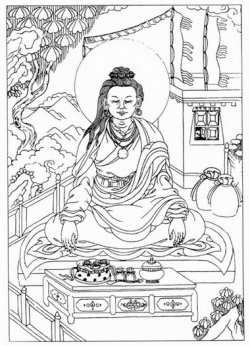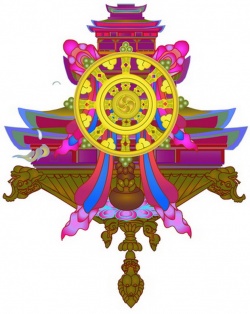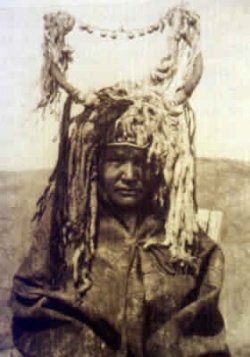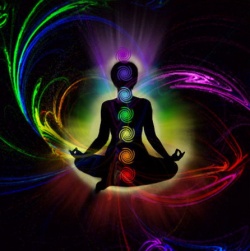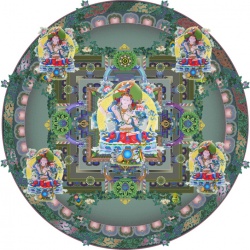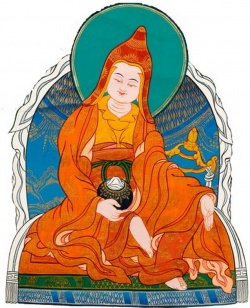An introduction to the Four Foundations of Mindfulness
Introduction
As always when listening to a teaching we first of all develop the motivation of bodhicitta, the awakened mind intend on the greatest possible benefit for all sentient beings: enlightenment. In order to realise this and to establish all beings in that state we engage in Dharma study and practice.
The Buddha taught the four foundations of mindfulness as the basis of all meditation practice in the Satipatthana Sutta, the tenth sutra of the middle length collection (Majjhima Nikaya) of the Pali canon. This sutra is the basis for the mindfulness practices of all Buddhist schools. Further explanations are found in the Anapanasati Sutta, where the Buddha talks about mindfulness of breath as a means to develop all four kinds of mindfulness, and in the Kayagatasati Sutta, where he develops the instructions on how to practise mindfulness of body by giving many examples. These three sutras together are the heart of mindfulness practice in the Theravada tradition. Gampopa mentions the four foundations of mindfulness in the Precious Ornament of Liberation as the factors to be developed right from the beginning of one's practice as one is entering the normaler path of accumulation. They constitute the first four of the 37 factors of enlightenment.
Here, in the context of this brief introduction, we will not discuss all aspects of mindfulness but concentrate on what the Buddha called the "Four Foundations". Mindfulness itself would be a still vaster subject as it includes virtually all practices starting with being mindful of the preciousness of our human existence, impermanence, cause and effect, suffering, continuing with a mindfulness of the qualities of refuge, of bodhicitta, of the masters, yidams, and protectors, and finally being mindful of mahamudra, the nature of things itself. Mindfulness is what makes our practice work. Without it, no practice whatsoever will have a profound effect.
When explaining the four foundations of mindfulness the Buddha first talks about the motivation to develop: the wish to obtain complete liberation, nirvana, the complete purification of clinging to a self which means the same as going beyond all suffering, beyond all worries and complaints into true happiness. He then says that in order to practise the four foundations of mindfulness, no matter which one we intend to practise, we should go to a secluded place, sit with crossed legs, and with a very straight upper body first let our mindfulness gather in front of us – not necessarily with the help of an object, but simply through resting with unwavering, steady eyes. Then, through contemplating the nature of samsara, we should relinquish all desire, all wanting, all clinging to the cycle of existence and dissolve all sadness and evil-mindedness. With "sadness" the Buddha meant the sadness which arises in the beginning when we take the resolution to leave samsara behind, an uneasiness due to leaving our beloved attachments. There should be no such sadness in our mind when we are letting go of the causes of suffering (!), but rather the great joy of a firm resolve to go towards liberation and to become able to make it accessible to all others as well. In order to practise mindfulness it is very helpful to have the support of a joyful aspiration.
Mindfulness is the practice of those who are happy to get out of samsara. Our basic attitude of mind should be free of clinging to this world. Having this as our basis we can develop the four foundations of mindfulness. For this we have to practise with diligence and with a clear, precise knowing of what we are doing, with clearly understood instructions on our meditation. Mindfulness means not to be forgetful, not forgetting the object of one's intention. Mindfulness needs to be accompanied by equanimity, a stable mind, not impressed by whatever might appear in mind, and it should be continuous, without interruption; not sometimes mindful and sometimes not. A continuous mindfulness is actually based on a deep letting go, just as Gendun Rinpoche always instructed us. Mindfulness establishes itself naturally when we have no interest for the world and let go of our worldly preoccupation.
But there could also be spiritual preoccupations that create obstacles: a strong wanting to let go, one is struggling to find relaxation with the hope to attain something and the fear not to obtain it. When there is too much wanting we will soon reject mindfulness practice, since we will not be able to enter authentic relaxation. Wanting agitates the mind, and so do hope and fear.
The Buddha taught four foundations of mindfulness which are set out in a progressive order and serve as foundations to discover liberation:
mindfulness of body
mindfulness of feelings
mindfulness of mind
mindfulness of Dharmas
The mindfulness developed with these practices is always the same: to be aware of what is. But the methods used to develop and keep the mindfulness change and become increasingly more subtle.
I. Establishing mindfulness of body
The basic instruction of the Buddha on mindfulness of body is: "Regard the body as body." It means to regard whatever is body, whatever has form, as being simply a physical form and not my body, my form, not to identify with the body, but just to regard it as body, an agglomeration of physical constituents. To see what the experience of these physical constituents is like is the next step of this meditation.
The initial instructions for this mindfulness could be condensed into the question: "What do the senses perceive?" This refers to the five physical senses (without the mental sense): whatever can be experienced through touching (inner physical perception), hearing, smelling, tasting, and seeing.
There are many ways to develop mindfulness of the body. All are meant to lead to non-identification with the first skandha of body or form. The most important of these methods is the meditation on the breath. But first we will give the list of other meditations which can be done according to the Buddha:
meditation on the impermanence of all body feelings and of all forms including the contemplation of the causes of their appearance and dissolution
meditation on the non-attractiveness of the body which is made up of many, not very attractive parts like bones, blood, flesh, tendons, mucus, excrements etc.
meditation on the fact that the body is composed of the elements earth, water, fire, and wind which leads to an understanding of the interdependence of physical phenomena
the traditional contemplation of the charnel grounds, where one contemplates corpses in different stages of decay: very fresh, one hour old, a few hours old, a day, three days, a week, a month, down to the last dust after years of decomposition. And at every step one should remind oneself: "My own body is of the same nature as this body. As soon as the breath stops, it will not be any different from these corpses, since it is also a composed phenomena." The contemplation of what one sees in the charnel ground or what one imagines in one's visualisation should at every step be brought in connection with one's own body to which one clings so much. One should become completely aware of the conditioned, impermanent nature of this body.
All of these meditations are also mentioned by Gampopa in the Precious Ornament of Liberation. They are important remedies for desire and ignorance. Further meditations to develop mindfulness of body are:
meditation on feelings of well-being and joy in the body using physical meditation experiences
meditation on how the body is subject to climatic influences, to heat and cold, to hunger and thirst, sometimes feeling heavy, sometimes light etc.
mindfulness while moving with the body, walking, sitting down, lying, eating etc.
It is actually very important to be mindful of our physical movements. If we are not even mindful of our body, how mindful will we be of our mind? Physical movements are few and actually quite slow, while mental movements are many and extremely quick. The point of practising mindfulness of body is to develop the capacity to refrain from unwholesome acts with body and speech, to settle the mind and to gradually arrive at a mindfulness of mind itself which is the chief of all actions, the starting point for all creation of karma. Mindfulness of the body is definitely more easy to practise than mindfulness of mind.
Mindfulness of breathing
The Buddha taught extensively about mindfulness of breath. Body mindfulness in relation to breath means to be aware of breathing in when breathing in, and to be aware of breathing out when breathing out. To know that one is a short breath and another is a long breath.
Mindfulness of breathing further includes to experience fully what the Buddha called the "breath-body". This is a term which refers to the whole body of subtle energy movement, the circulation of the inner breath as one is meditating the outer breath. We do not limit ourselves to watching the breath at the nose or as it makes the abdomen rise. We extent our awareness of breathing to include the whole body. The whole breath-body is breathing. In this way one should use the meditation on breath to calm down physical clinging. One can also calm down physical sensations with this mindfulness. Up to here this belongs to mindfulness of the body.
The Buddha further taught mindfulness of breath as including all four foundations of mindfulness. He showed that while being mindful of the breath one can be mindful at the same time of the sensations, the feelings arising in relation to all six senses. As one is connected with the breath one can also be mindful of the different meditative absorptions with their experiences of physical joy, mental joy, end of analysis, and so on. This is also classified as mindfulness of feelings. But to be mindful of them does not mean to cultivate them, it just means to be aware and not to cling. The use of these states is only to open up our innate wisdom which will help us to go beyond them.
While meditating on the breath one can also be mindful of the mind. This includes, according to the Buddha, first of all to fully experience the mind (to be in full contact with the various states of mind, not to be distracted); secondly, to increase the joy of one's mind, thirdly to focus the mind and fourthly to liberate the mind.
Being mindful of Dharmas linked to mindfulness of breathing includes meditation on impermanence, on renunciation, on the coming-to-the-end of clinging and on complete letting go.
All of this was taught in the Anapanasati Sutra, where it is indicated that the breath can actually serve as the key method to develop all four foundation of mindfulness.
For the interested practitioner we include here some oral Instructions of Gendun Rinpoche on mindfulness of breathing :
"When we follow the movement of our breathing in and out, it should be left quite natural, just as it is. We should not force either the body or the mind in any way at all but remain completely relaxed and simply let the mind become aware of the coming and going of the breath, without any distraction, any other thoughts, anything else catching our attention. Let the mind merge with the movement more and more until it is completely absorbed in it. Do this first for 21 breathing cycles, without distraction, and then for a greater number, all the time staying attentive.
Staying attentive does not mean concentrating fixedly on the breathing while saying to yourself, „I mustn’t lose the movement, I must stay concentrated...". If we start this kind of discursive thinking, it will create a level of mental agitation which will disturb the natural movement of the breathing and of the meditation. We are no longer meditating, we are commenting on the meditation. We lose our sense of being absorbed in the meditation.
What we have to do is simply be aware of the breathing, feel it, experience it physically and mentally. We should follow it without doing anything else, without comment, without trying to change it or modify it in any way. For that we have to be very relaxed, very quiet, and practice gently, regularly. Doing this, we wait for the calm that will allow us to penetrate more deeply into the meditation to develop."
Do I want to dream or do I want to be present?
If we summarise Trungpa Rinpoche's teaching on the mindfulness of body, we should ask ourselves: "Do I want to dream or do I want to be present?" If you want to dream, don’t practise mindfulness of body, it might wake you up. However, if you want to be present, practise mindfulness of body. Being mindful of the body means to really come in contact and establish a direct connection with our body. It means to sit on the earth and walk on the earth instead of being in our clouds of imagination.
There is a certain simplicity of physical presence which installs itself and lets us find the way out of our concepts. Our complex, conceptual, always thinking mind is calmed down by feeling the simple presence of walking or of being here on the cushion. It means to relax into the body and to just sit or walk or breathe without wanting anything special, without wanting to go anywhere. It is not the destination that counts but being or walking itself. That's enough. Buddha gives us the permission to just be.
Here, on the first level of mindfulness, there is not yet an intention to analyse or understand something, there is just this basic presence which gives rise to an openness. And this is very helpful! It can also be helpful when you cannot fall asleep at night. You practise a bit of mindfulness of breathing – and relaxation is coming, openness, and it will be more easy to fall asleep, because the agitated subtle energies calm down due to the mindfulness of breathing.
So, Chögyam Trungpa says: When we contact this feeling of having a very stable ground, our practice becomes linked to what and where we really are. Then, on this very stable ground of being in contact with what really happens, we can open up – we can open up to the surroundings, and also to other practices. But first we need this stability, a feeling of coming home. Thich Nhat Hanh compares it to a child coming home after a long time of absence. To find back home is already a big step ahead on our path.
Continuing our practice of mindfulness of body in the vajrayana...
Also in our vajrayana practices we work a lot on mindfulness of body. The aim here is to lead us to a complete integration of body, speech and mind, and to come to an understanding of the deeper reality of these three. The training begins with mindfully turning a mala in synchronisation with our mantra recitation. We prostrate with our body at full length being fully aware of the outer movement, doing it just the way it should be, and develop at the same time the mindfulness of its inner meaning of going for refuge etc. The body is used as a support to always find back into a virtuous state of mind or into contemplation or meditation. We offer mandalas or perform mudras at the same time as we are reciting and visualising. In meditation we train in the correct posture and we are using mantras and doing recitations. (In this fourfold classification mindfulness of speech also belongs to mindfulness of body, because it is an outer act.)
Mindfulness of the body also means to be in tune with our body, not to abuse it, but to remark when we are tired, stiff or cold etc., and to adjust our practice accordingly through changes of position, food, drink, clothes, heating, cooling, rest, sleep, exercise, and so on. To be a yogi actually also means to know what our body wants to tell us. We should generate an attitude of sensitivity, warm-heartedness and non-violence towards our body while not falling into laxity and self-cherishing attitudes. Our body is not simply the slave of our practice but actually a very subtle tool to develop awareness. In vajrayana we even say that is the seat of enlightenment.
When visualising ourselves as a Buddhaform (yidam) we practise mindfulness of body on a still more subtle level. We refer to a deeper reality of "body" in order to bring us to an awareness of the transparent, non-substantial nature of body and form, and to let go of identifications with this normal physical body. Here, our mindfulness is directed to reality as a Buddha sees it, and it will extend our practice of mindfulness beyond all limiting concepts of what we usually consider as "body". All of this is the integration of basic body awareness into the heightened awareness of vajrayana. It is the natural continuation of the experiences of down-to-earth body mindfulness which becomes more and more tuned in to the subtleties of being. When Body is experienced as the subtle reflection of all that happens within and around, it is perceived as the mirror of the whole universe, it reveals its truly sacred dimension. Everything and everyone is seen as contained in that supreme Body of the yidam-divinity.
Mindfulness of body finally leads us to the understanding that all phenomena, all forms, all ‘bodies’, are free of inherent existence, empty, completely pure, interdependent and transparent – just like reflections on a pure mirror or on clear, unmoving water. This is the true, final simplicity of "just being", which is the key to mindfulness of body right from the very beginning.
Question: Can we also apply this teaching on mindfulness of body to thoughts?
Answer: Yes. There is actually no difference between outer, physical form and inner form, mental representations or thoughts. As you meditate on the body, you realise that the body is not outside of the mind. And as you meditate on form, you realise that form is not outside, but that there is no difference between thoughts which are purely mental and thoughts which seemingly have an outer support. This is one of the understandings arising due to meditation on mindfulness of the body: the separation line between thoughts, body and outer surrounding dissolves. We can find no more limits to this constantly changing, completely inter-related phenomenon which we call body. Inside–outside becomes completely transparent and indistinguishable. That’s why meditating on the body can be the source of all realisations.
II. Establishing mindfulness of feelings
The second foundation of mindfulness is the meditation on feelings or sensations. And here the Buddha’s instruction is again very simple: "Regard feelings as feelings". These are just simple feelings, not my feelings. This has given rise to the instruction to mentally say, when there is an agreeable sensation arising: "agreeable sensation", and if disagreeable, to just say: "disagreeable" – end of the story, no further comments.
According to the Buddha what we call mindfulness of feeling is a simple, non-judging awareness of agreeable and disagreeable (even sometimes painful) feelings and of "neutral" feelings, which refers to meditative absorption states (samadhis). And also he instructed us to cultivate the awareness of "worldly" and "spiritual" feelings and of their combinations as agreeable worldly feelings, disagreeable worldly feelings and so on. The instruction can be condensed into the question: "What is felt inwardly when a sense impression arises?" The idea here is to just feel, in a direct way, without any commentary – and to see the reactions of immediately judging any experience as agreeable or disagreeable, to become aware of these judgements which are constantly happening in our mind. To become aware of them gives us the possibility to stop the chain.
Our feelings will be accompanied by awareness, and as we are aware of them and the connected judging process, we can find ways to let go of them, one after the other. Due to mindfulness we can avoid further chain reactions with all the connected emotional trouble. Mindfulness of feelings also has the effect that we get to know ourselves better and do not run away from our feelings anymore. They become familiar experiences of great variety but without any special importance. In spite of their great variety they are all the same in one respect: they come and go without leaving traces. This meditation gradually leads to non-identification with the second skandha: feelings or sensations. Feelings will then arise without secondary thoughts that create a connection to an imaginary I or self. They are simply what they are: feelings, a flow of experiences, ever-changing. Do you see any self in this?
You can look on your feelings from within, as a personal experience, or from without, as if someone else was experiencing them, as if looking on yourself from the point of view of an outer observer. Both ways of practising are taught and both are ok. But according to the Buddha we should look also what gives rise to feelings and what causes their dissolution. We investigate into impermanence and the conditioned nature of feelings. We take an intelligent look into feelings. It is non-judging, and because this creates a certain space, the non-judging allows for an understanding to arise. We see how pleasure is arising and how suffering is arising. We see how pleasure goes away and how suffering goes away.
So this is one way of practising with feelings, using our intelligence and our curiosity to investigate, and the other way is to be simply aware of what is happening: only being aware, no need for an effort to understand something, just as in the basic mindfulness of body: a very simple mind, nothing more. First one should establish basic mindfulness of feelings, becoming aware of their coming and going, and then occasionally one investigates into the causes and factors of the arising and disappearing of feelings, judgements etc. One can, if one wishes, take each of the different senses as a support for the mindfulness of feeling and see how mind immediately judges these feelings. We take sounds as our support, odours, tastes, physical sensations, the moving wind, an itching sensation – all kinds of supports, and each time we look what this does in mind.
We notice all the thousands and millions of judgements going on in our mind, and what usually happens is that we become thoroughly disgusted with ourselves, with all this liking and disliking. But what to do? It has been going on for a long time already. Now we become aware of it, that's great!, and soon we will be able to relax with it, and then actually we will be able to let go of it from time to time, until we come to truly enjoy the non-judging mind. Then there is no more struggling to let go. It becomes our preferred mode of being.
Question: Is this being mindful of judgements or still mindfulness of feelings?
Answer: They are interconnected. If you can just remain on the level of feelings, you are already an advanced practitioner. Normally we are caught in judging before we even realise it. You will for example see that as soon as you hear the sound of a tractor, there will be a naming "tractor". You think that the naming is the thought immediately after the sense perception. But before this rather complex naming has happened, you have already, more or less unconsciously, judged the sound as being agreeable or disagreeable. In meditation you will see all of this. Mindfulness of feelings is actually in the beginning a mindfulness of how every feeling triggers off a chain of reactions. Later then, as a more simple awareness installs itself, you will come to the level of simply feeling feelings, without further comments, and the difference between the sound of a tractor and the lovely voice of a woman becomes less and less.
Question: Agreeable – disagreeable comes before the naming?
Answer: Yes, long before. A name is already a complex concept. You have already made the difference between this sound and all the other sounds, car sounds, animal sounds and so on, which you know. You have already zoomed in. You’ve gone back to your memory, compared with similar sounds which you knew and heard in the past. You compared and, while taking into account still more factors of the situation, you said: "This is probably a tractor." So there is a lot, which has gone on. Agreeable – disagreeable is the first, immediate reaction of the mind to the sense-perception. It is the reaction which will decide whether we take a protective or open attitude towards the situation.
How can survival come alive?
Summarising Trungpa Rinpoche's teaching, the central question of this mindfulness would be: "How can the basic survival instinct become mindfulness of life?" Normally, all our actions (breathing, eating, clothing...) are motivated by our basic instinct to survive, and all our interpretations of feelings are done in relation to wanting to survive. I judge all of what I hear, feel and so on as either being dangerous or not dangerous. "Can this be a help to me, can I profit from this, or might it trouble me, take something away from me, make me poorer?" This survival trip continues all the time unconsciously in our mind.
Mindfulness of feelings teaches us to simply be aware and to notice that we are already surviving. Every feeling, every sensation signals us that we are alive! And we notice that life just continues from instant to instant without any effort from our side. In this way we get out of these constant worries connected to sensations. There is a little hunger arising, but one doesn’t have to react immediately. We just observe this lively feeling of hunger come and go, and then of course we can also do something about it. When there is a bang somewhere, we do not need to tense up, we can just observe. There is no need to always tense up when something is happening.
Some quotes from Chögyam Trungpa, Rinpoche: "Survival instinct is transmuted into a sense of being... and mindfulness becomes a basic acknowledgement of existing. Meditation becomes inseparable from the instinct to live... and that instinct can be seen as containing awareness, meditation, mindfulness. The life force that keeps us alive and that manifests continually in our stream of consciousness itself becomes the practice of mindfulness. ... We can simply tune in to our process of life... Just living is enough without reassuring yourself that you are living. If you don't stop [the process] to make sure, living becomes very clear-cut, very alive and very precise. ...Meditation is the total experience of any living being which has the instinct to survive!"
Living fully means being fully present in the moment without worrying thoughts that prevent direct contact. Trungpa Rinpoche advises us to simply remark what is, to shortly zoom into it and immediately let go. Touch and let go! This means that we touch, we get to know, we see, but we let go quick enough to always be in the freshness of the moment. And it is this freshness, which opens up to the flow of life. Life is a flow of sensations, a flow of feelings. Life is a constant flow of perceptions, feelings and sensations. Instead of falling into fear we develop a basic confidence that we do not need to control all these sensations. We don’t need to hold on to some and push away others. We can allow ourselves to let the flow happen in our mind. This is the basic notion of relaxing into mindfulness of feelings.
For this there has to be a giving up of wanting to manipulate the world on this very basic level. Our ordinary survival trip makes us want to manipulate the situation: "This I want, this I don’t want." In basic mindfulness there are no such second thoughts, there is no personal, ego-centred interest in our contact with life. It is a very simple presence.
Ego-centred mindfulness however is exactly the opposite: the watchman on the tower who is always on the lookout for opportunities or enemies. This is ‘survival mindfulness’ in which there is no equanimity and letting go. We should not cultivate mindfulness as a further elaboration of our survival skills, but I suspect that this is offered in some of those meditation seminaries for managers. We do not practise meditation in order to become more performing so that we can better snatch away opportunities from others.
Chögyam Trungpa says, to hold on to feelings of life brings the feeling of death. If we grasp onto life we are already half dead. That is the motor of depression. Grasping onto live kills live. The holding on to some aspect of our life due to our urge to survive takes us far away from what is actually happening. We are in our personal dark room of clinging. And this darkness we are holding onto. When we let go of this clinging we immediately get the feeling: "Oh, as if I hadn’t seen the sky for a long time. Oh, the freshness of the wind!" Suddenly simple, fresh presence begins to re-enter our awareness. When this happens it is the sign that our depression is coming to an end. When the freshness of the moment comes back, this is the end of death and the beginning of joy.
Actually, we grasp because we are afraid of death. But if we manage to just be there and relax, mindful of one breath after the other, we will know that we have survived yet another moment and that we can permit ourselves to relax the next moment as well. No need to grasp. Thich Nhat Hanh says: "Working mindfully with disagreeable feelings grants us insight and wisdom." Yes, the wisdom of no fear to die, the insight into the truth of non-self, and the courage to patiently face one feeling after the other knowing that due to mindfulness there is no need to fear that we will be overwhelmed by them.
For mahayana practice it is very important to open up to feelings, because every contact with another person brings feelings, agreeable and disagreeable ones, emotions. You cannot be a bodhisattva without opening up to feelings. How will we be able to help others, if we are not open to feelings and willing to let them pass through? How will we be able to face all the problems of beings to liberate, if we cling to experiences? It is also important that our mindfulness is not a cold observer, but rather, to quote again Thich Nhat Hanh: "like a lamp shedding light – not a judge", and: "like an older sister lovingly taking care of her younger brother or sister". A lamp does not only give light but also warmth. In the same way our mindfulness is not only an expression of wisdom but also of compassion and love. We smile at ourselves and occasionally give ourselves a hug: a compassionate approach to samsara; bodhicitta applied to all beings, including ourselves!
Continuing our practice of mindfulness of feelings in the vajrayana...
In the vajrayana we consciously open up to feelings, we invite them as part of many practices. For example, when we celebrate a feast offering (tsok) together, this gives rise to intense feelings of all kinds and related to all senses. There is an opening up to sense-impressions, an entering into life. Also the practice of setting up a shrine and making it very beautiful is an expression of appreciating feelings, visual forms in that case. Music, incense, singing, playing instruments... – actually, in the tantra we are encouraging feelings to become stronger in order to see better there true nature. We see them as messengers of wisdom.
True mindfulness of feelings is to see their true nature. On the first level of mindfulness of feelings we simply realise the presence of a feeling: Anger is there. Then we see its impermanence: Anger is already gone! Then we see its interdependent origination, the fact that it is not just arising out of the blue, but in chains of cause and effect: Anger arose when clinging to an experience judged as disagreeable etc. And due to seeing the interdependence of feelings we also see that they are illusory, devoid of a lasting essence: if they are gone, they are gone, they don’t leave any traces, they do not occupy any space anymore. Anger is gone and seems like a bad dream which has passed. I cannot even find it any more. And then we understand from within that this can be called emptiness, the emptiness of feelings: In all of this anger there is no self. Looking into it as it arises, there is nothing to see. When looking into it, it is seen no more, as if a bubble was pierced.
On the vajrayana path we see all of these feelings as the experiences of the meditation Buddhaform (yidam) or of the lama. We meditate on these feelings not as being our own feelings, but the feelings of the yidam in the space of primordial awareness. There is no more need to worry: feelings arise as the play of awareness in endless space. We come in touch with the true nature of feelings: constantly changing, just like the wind in constant movement; constant activity without any substance – and, if not clung to, this movement is seen as the expression of joy, of great bliss, the perfection of whatever is appearing. It is the expression of the great compassion of non-clinging enlightened mind without self, without any reference point, which is constantly active for sentient beings. It is the spontaneously creative aspect of mind's nature. When there are no dualistic reactions to these movements, these feelings, they are understood to be perfect by nature. There is nothing to be changed in these feelings, since they are the spontaneous, unceasing creativity of mind itself. This is truly "being alive", fully open, without any clinging.
III. Establishing mindfulness of mind
Again, the instruction of the Buddha for mindfulness of mind is simple: "Look at mind as mind". Not as my mind! The Buddha was very simple in his teaching, very straightforward, but when putting his advice into practice one quickly sees how profound his teaching is. The instructions to this third mindfulness could be condensed into the question: How is the mind right now?
The Buddha asks: Is there desire, is there hatred, is there ignorance? Is this mind of the present moment normal (narrow) or wide? Is it concentrated or distracted? Is it a noble or a samsaric mind? Is it surpassable (limited) or unsurpassable? Is it liberated or not liberated? Tensed or relaxed?
The Buddha taught the first level of mindfulness of mind as being a simple, non-judging mindfulness of the present mental state. Look into the mind as if looking into a mirror, and you will see: "Ah, quite tense" or "Oh, quite open" or whatever: desire, hatred and so on – simply note what is present.
Then mindfulness goes a step further to examine the causes for the appearance and dissolution of the various states of mind. To learn in this way about mental states and their conditioned nature will then help to quicken our letting go of a given situation. We will know how we can encourage wholesome states of mind to arise and what will be favourable to the quick disappearance of unwholesome states. Due to this mindfulness of mind we also begin to know the qualities and capacities of mind. Emotional wounds begin to heal and knots in our mind are loosening.
Basically, mindfulness of mind always remains a simple mindful presence without investigation. The investigation we talk of is not a conceptual thinking about mind. It means to be present in such a way that you notice the arising of an emotion, you notice the thoughts just before its arising which trigger the emotional reaction, you notice your body sensations, images etc. before the emotion, during, and afterwards. Because we are aware of the mind we notice how a mental state disappears, what thought precede its disappearance. We see for example for desire that it disappears at the time when we contemplate impermanence or generosity, or that it simply disappeared when we had another thought which was stronger, more interesting. We notice many things about how the mind works, and this is what stimulates wisdom and understanding. There is a trace of understanding which rests after having witnessed the mind's working. We do not search for this understanding, it is enough to be mindful, the rest is automatic.
Mindfulness of mind is already quite subtle, we have to be increasingly relaxed to notice these workings of our mind. This is not a gross level mindfulness anymore. Going from mindfulness of body to feelings and then to mind, we need more experience in not interfering with what we observe. Normal practitioners cannot start with their mindfulness training directly on the level of mind; they have to start on the level of the body and feelings. In the beginning it might already be difficult enough to just watch the breath without manipulating its rhythm and depth.
Remaining indifferent or becoming interested?
If we condense Trungpa Rinpoche's teaching on this point into a headline, it could be: Do I remain indifferent or do I become interested? What attitude do I take towards my life, towards my mind? Am I interested to know the mind and to get out of samsara? Or am I indifferent to these questions and prefer ignorance and stupidity? Stupidity means to be indifferent to what is happening, not to care about one's own future or about others etc. To Trungpa Rinpoche the whole teaching about mindfulness of mind is about "mindfulness of effort".
The point here is to practise with balanced and determined effort, and such right effort is based on right motivation. According to Gendun Rinpoche, when we develop the motivation of bodhicitta – a truly selfless, compassionate, and most profound dedication to enlightenment – right effort and right mindfulness will come naturally, and meditation will be easy. Bodhicitta is the key to mindfulness and insight.
In order to reach enlightenment, true awakening, we need this true mindfulness, which is an intelligent mindfulness combined with the unwavering, authentic effort of compassion. This effort is free of the over-enthusiasm of ambitions and without the heaviness of pressure and the feelings of duty. We do not practise out of duty nor out of ambition. True effort will not arise due to an order, an obligation or just because one wants to get somewhere.
In the scriptures right effort is compared to an elephant: an elephant who walks steadily and cannot be stopped. He walks with confidence and certainty, and his mindfulness is completely balanced. With panoramic awareness he walks through the jungle. He is interested in the jungle, not absent-minded, his senses are very keen. This open-minded interest, however, does not make him lose his inner balance. This image is not used only because the elephant is very tall, you could also take a turtle as an example. What is pointed out here is this certainty without hurry and wanting. The movement within space is itself what one is interested in. Mindfulness in tune with movement is what leads to liberation. It is a sure movement that cannot be stopped, full of dignity, not agitated, with a panoramic view, and it has a playful lightness and intelligence to it. It is sensitive, but not hesitating. It is serious, but not too serious. It is decisive, but not tense. This gets the mind out of its dream world. We look into the mind's working, and we look into the reality of mind.
At first we use our observer, the abstract, non-emotional observer to know the mind. We use dualistic functioning in order to better know the mind. There is nothing wrong with using dualistic mind processes: we can use this observer to get out of emotions instead of entangling us more and more. Observing will help us to get out of the emotional jungle into a non-judging presence, from moment to moment, without comments.
Trungpa Rinpoche describes sudden moments of direct seeing which then appear, little gaps that open up to a deeper insight. These moments only happen on the basis of discipline, a disciplined elephant-like mind which is not distracted. While walking as the elephant through the forest of our mind, being continuously in touch with what is happening, there will naturally be these moments of insight, just as when the light is coming through the little openings in the forest. Suddenly we see very clearly. In the middle of darkness and confusion there are moments of direct seeing.
